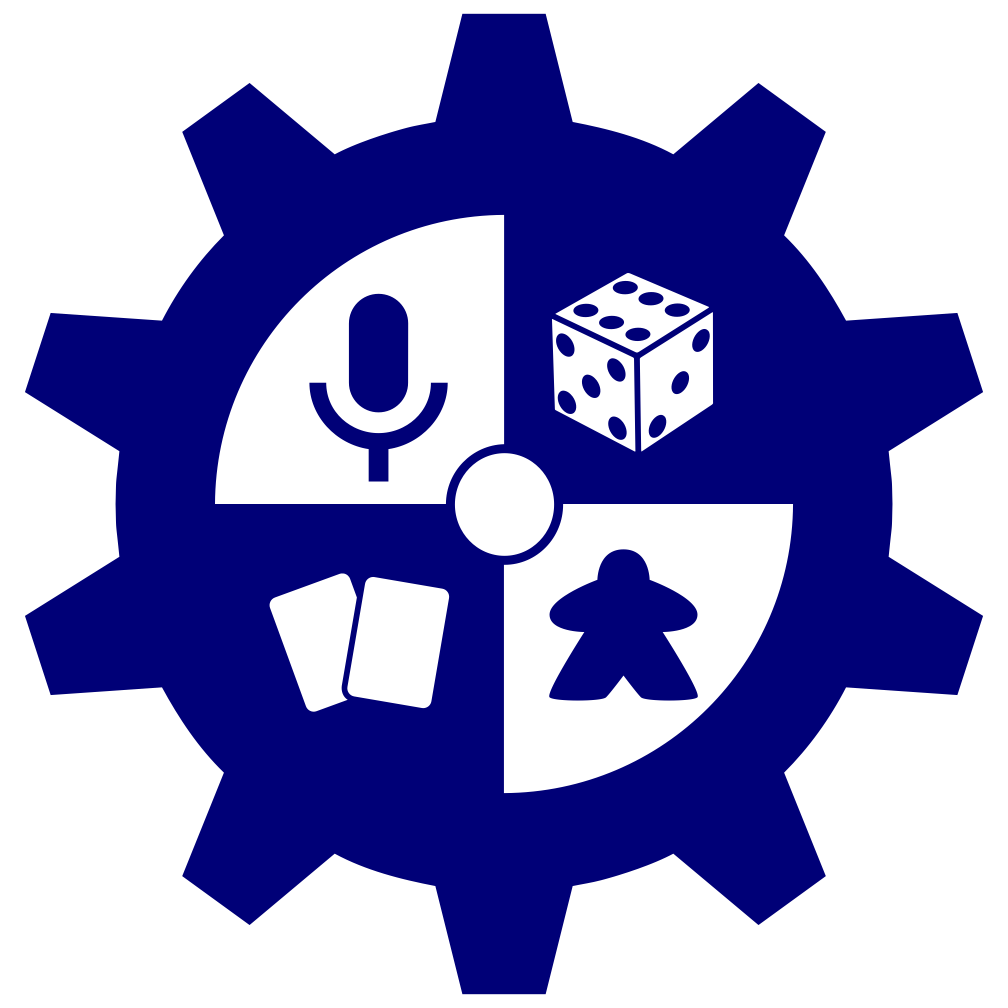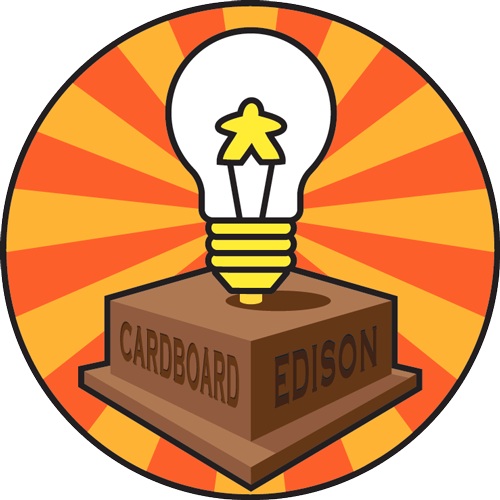Guild Update
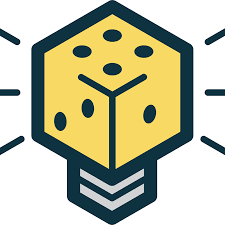
COVID and Guild Playtest Meetings
Currently we are allowing playtest facilitators for each location to determine if meetings will be held, as long as they fall within state guidelines. Updates on the status of these meetings will be announced via our BGDG of Utah’s Facebook Group. The Layton and Pleasant Grove groups seems to be meeting with some regularity. The Salt Lake group is checking in with Demolition Games at this time.
Discord and the Guild
The BGDG of Utah’s Discord is a great way to get to know those in the guild and discuss all things game design! If you’ve not joined yet, we’d love to have you come and participate with us!
BGDG of Utah Social Media
We have an active Twitter and Instagram account now! Please follow and start using #bgdgofutah in your game design related posts and they will be liked, retweeted etc!
Upcoming/Current Events
SaltCON End of Summer is back!
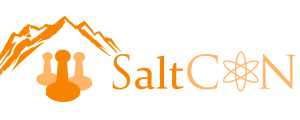
SaltCON End of Summer has been announced! This will take place from Friday, July 30th – Sunday, August 1st. Badges opened up on May 1st. Badges are currently sold out but there may still be volunteer badges available (4 hours of volunteering for a full convention badge).
Protosynthesis
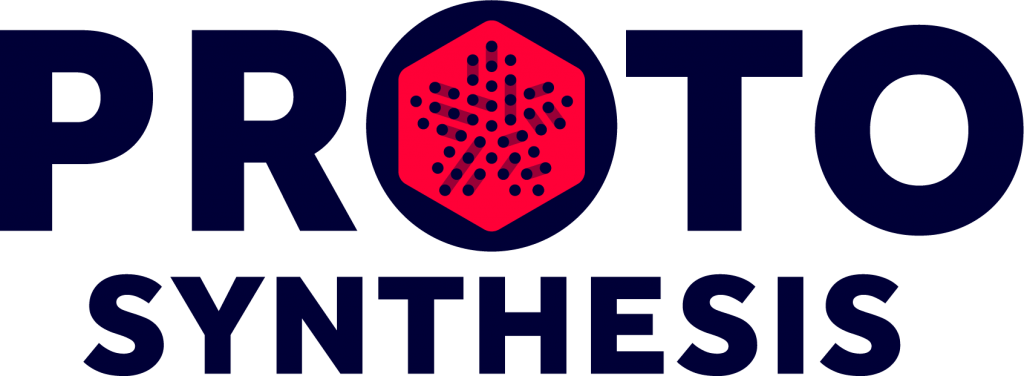
Not to be confused with ProtoCON, Protosynthesis is an online playtesting event that will take place on August 28th and will run all day! We held our last Protosynthesis in February of this year and this time we are hoping to have more games and more playtesters than before! We are opening this up to non-guild members from the start, whereas we only did that at the last minute for the previous event.
If you would like to participate as a Game Designer then please complete the submission form below! Submissions will be available through Sunday, June 27th.
If you are interested in participating as a playtester then please complete the form below. IMPORTANT: if you are submitting a game as a designer then you do not need to fill out the playtester form as you will already be expected to be a playtester (it’s just common courtesy).
ProtoCON 2022
We are currently preparing for ProtoCON 2022! This will take place in January of 2022 and will be an in person board/card game prototype event! Last year was so much fun and it was sad that we had to cancel plans for 2021. Please stay tuned for more information on ProtoCON 2022!

Current Design Contests
This seems to be the most board game design contests we’ve seen in quite some time! There’s some great opportunities here! Take a look!
Board Game Workshop Contest (06/13/21 Board Game Workshop)
Stuck at Home Design Contest (06/15/21 Gaming with Edo)
HABA USA 2021 Game Design Contest (06/22/21 HABA Games)
18 Card Challenge (06/30/21 Button Shy Games)
1 Card Print and Play Contest (07/01/21 BGG)
Roll and Write Contest (07/16/21 BGG)
World Original Design Contest of Board Game (07/18/21 YOKA games)
Korea Board Games 2021 Design Contest (07/30/21 Korea Games)
XYZ Quarks Design Challenge (07/31/21 XYZ Games)
Alley Cat Games Cooperative Game Competition (07/31/21 Alley Cat Games)
Bad Comet Co-op Design Competition (08/31/21 Bad Comet Games)
Small Box Challenge (09/30/21 The Game Crafter)
War Game Print and Play Design Contest (10/01/21 BGG)
Guild Related Videos and Games
Paperback Adventures
Oros
KS Preview page
Oros Website
Flawk
Nate Bosen, aka Enemby on Discord, has shared an Role Playing Game called Flawk that he’s been working on! You can check it out here! “Flawk is a simple, easy to learn role playing game, intended to create interesting characters in entertaining situations. It’s similar to D&D, but is much easier and quicker to learn. In my playtests, I had new players with complete characters playing the game without my help within 5 minutes.”
Board Game Community Podcast
Riley has done such a great job with this new podcast! There are quite a few episodes which could be featured here since the last newsletter. Go ahead and subscribe and start listening!
Ryan and Malorie Laukat were interviewed on the Ludology podcast recently.
Game Design Highlights by Dustin Dowdle
Ok, so in the past I’ve written up blog posts on cutting up cereal boxes for tokens and things like that, these are things we do to keep game design cheap and effective. This month I wanted to highlight the use of nanDECK, which is totally free, and appears completely overwhelming, and it’s not actually all that difficult to use. But some help initially is probably wise.
I should say that first off, I’m not using nanDECK to its full potential and I’m not even an expert in the small ways I do use it. I’ll offer up that I use it as effectively as I need to in order to save myself tons of time when iterating on designs I play around with.
What is nanDECK?
To best answer this I’ll post a quote directly from the nanDECK website:
“nanDECK is a software for Windows (any version) written as an aid for game inventors, with the aim of speeding up the process of designing and printing deck of cards (useful during prototyping and playtesting).
nanDECK is free, you can download it and use freely, without limitations (but a donation, of course, is really welcome).“
How do I Start?
The first thing I do (after downloading the program) is create a spreadsheet with the basic information I want nanDECK to use. Though I’m not showing the titles of each column below each of those columns has a title that describes all the information that falls below it. That way when I want the “Name” of the cards to go in the same spot for each card in a set then the name of each card goes under the column heading “Name”. Pretty simple. Any pictures I want associated with the card will be listed in their respective columns as well and be sure to have the spreadsheet and pictures saved in the same folder on your computer.
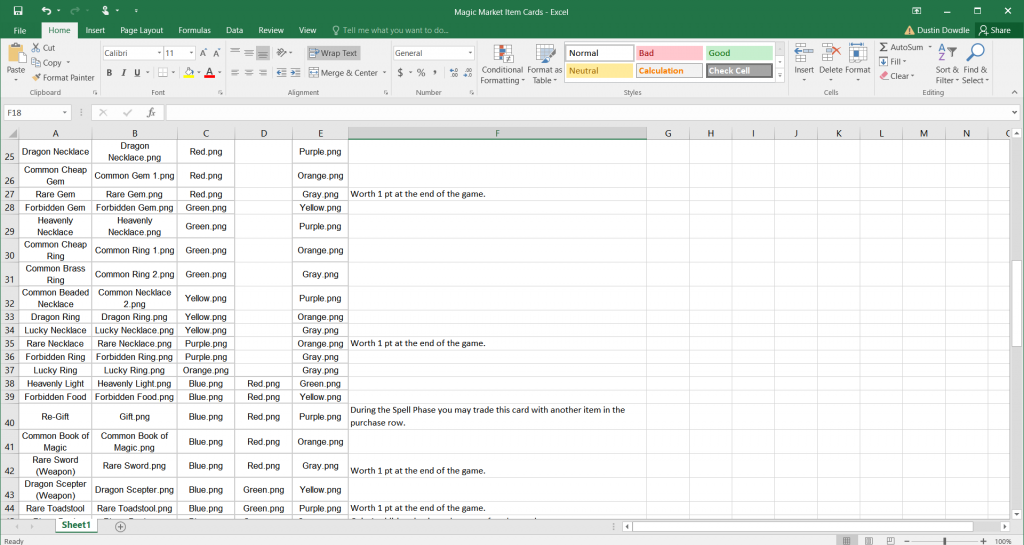
Once you’ve got a spreadsheet saved (and just know that you’ll be making lots of changes to this as you iterate) then you’ll select that particular spreadsheet to associate with your deck and start building it! Below you can see the code that’s all associate with a game I’m working on right now and I’m sure it looks a little intimidating (at least it did for me). When you start it will all be blank, of course. The good news is that you don’t really need to do much with this screen until you get far more comfortable with the program. Instead you can select the “Visual Editor” in the lower right.
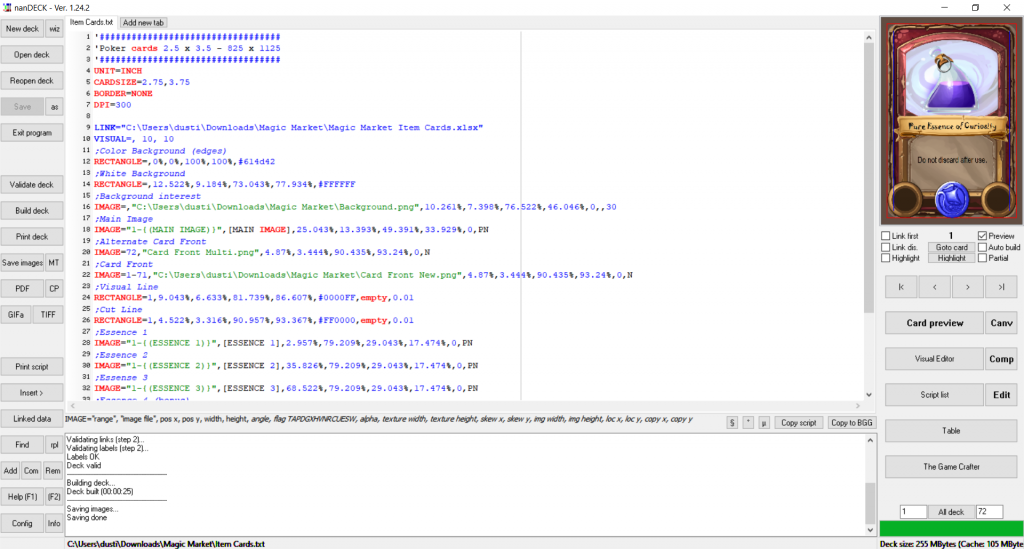
Visual Editor
This is where I do the majority of my work in nanDECK. As you start importing things like the “Name” of the card, just know that all cards will also have the “Name’ in the same spot unless you specifically make exceptions to that. Be aware that your card will not look as sharp in this, there will be lots of white edges around images, especially when using transparent .pngs, that’s now how your finished card will look. This just gives you an idea of how cards will be arranged.
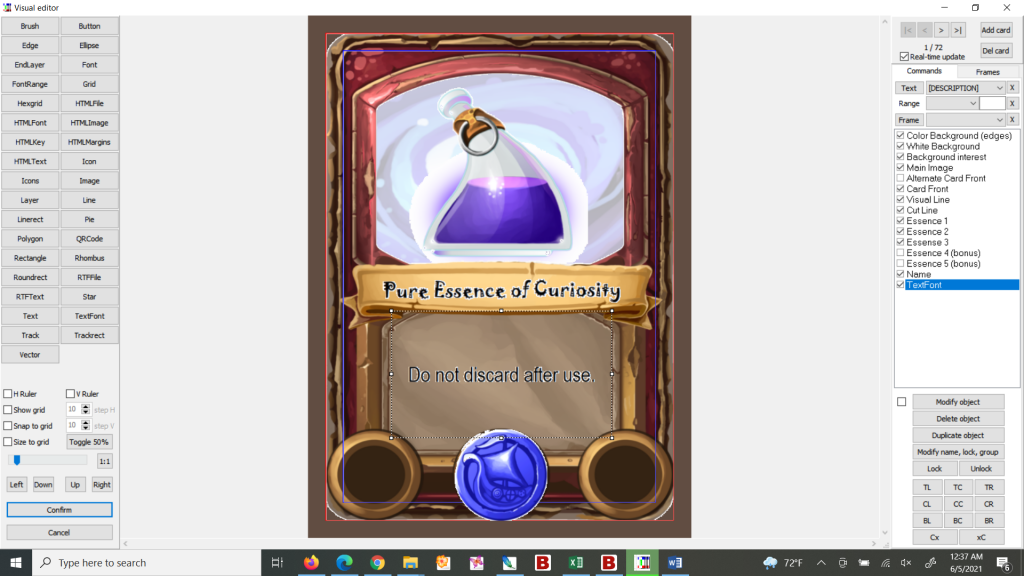
Once you’ve finished arranging how your card will look in the Visual Editor then you can “Confirm” it then “Validate” and “Build” your deck by pressing each of those buttons. As long as everything was done correctly then you’ll have your cards turn out like below! In the example I have here I have the cut line in red and the visual danger zone in blue according to The Game Crafter’s specifications. When actually sending the cards to print then those lines would be deleted.
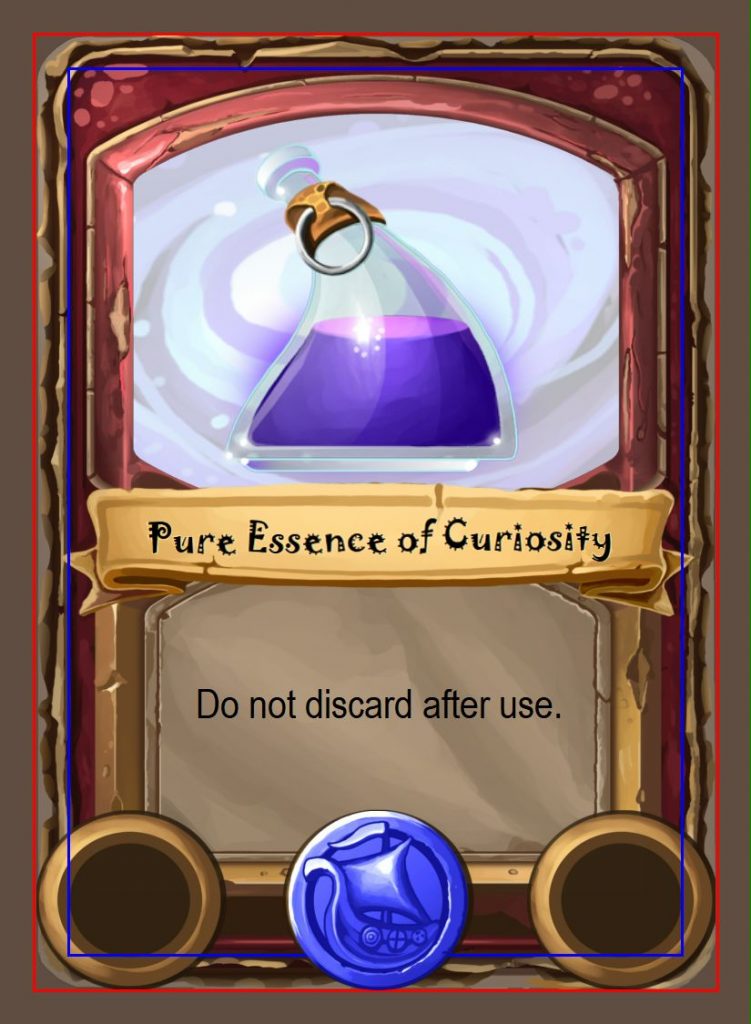
The wonderful thing about nanDECK is the fact that even though I was mainly focused on one card, all the cards below were completed at the same time! It’s important to cycle through your deck to ensure that everything fits the way it should and that there are no special changes needed for specific cards (as in my bottom right card below which is purposely formatted a bit different than the others).
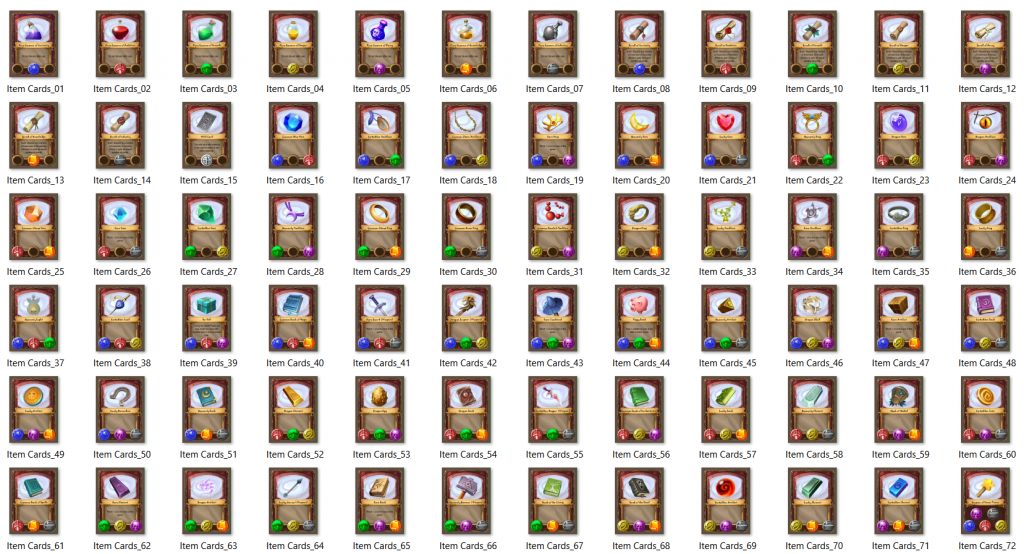
When the time comes that a change needs to be made to a specific card, suchas a name or description change, then I just jump into my little spreadsheet and make the update, hit save and it’s seriously that easy! Better yet, when all cards need a change then I can do that nearly as fast. I can’t tell you just how valuable it is to be able to iterate your game design more than I have already done. I feel like it’s totally worth the time to learn and figure out the bumps in the road with nanDECK in order to save loads of time in the future! There are of course some paid programs that may be easier (and run on Apple products) and that’s great as well. the fact that nanDECK is free and has a robust community around it and is beign updated all the time, it feels like a no-brainer.
Lastly, if you head to the nanDECK website then you’ll see some video tutorials that are far better than what I’ve explained here and will get you started.
Thanks for reading and good luck with your iterative prototyping!
Interview with Brandt Brinkerhoff

Personal Questions
What’s your backstory? Tell us about yourself and how you got into game design.
It really all started when I first moved to Utah from Chicago. We rented a house for a year to figure out where we wanted to end up. During that time I happened to live across the street from an aspiring board game designer named Charles. We quickly became friends and made the connection that I love playing games, he loves designing them, let’s playtest. Up to this point it had never dawned on me that my professional skill set in user-experience, creative strategy, and graphic design happened to apply so closely to game design and development. We spent many nights playing and discussing a few of his designs.
One evening he brought over an early stage idea that had a flattened out globe as a board and tiles that you could shift around. The idea was to try and scoot stuff around to build your land mass bigger than the other players. That map mechanic was a light bulb moment for me. All the brain spark plugs started to ignite and rather than sleeping, I spent the night wildly marking down all sorts of notes about shifting and colliding land, forming mountains and volcanoes, eruptions and chain reactions, earthquakes, player actions and interactions, and scared little people living in this chaotic world. It was this explosive brain dump.
The next morning I walked up to him with this wild scramble of notes and said, “what if your game did this, and this, and this!!!” He was either very impressed or outright frightened, but told me, “hey, if you can make a game out of this, take it and go make a game. I’d love to see where it goes.” So that really is what started me on this path. That’s the Oros genesis, and I’ve tried to hold on to that plate-tectonic concept as the heart of the game. Looking back at where the game started, and how it evolved, and what it has become, is pretty unbelievable.
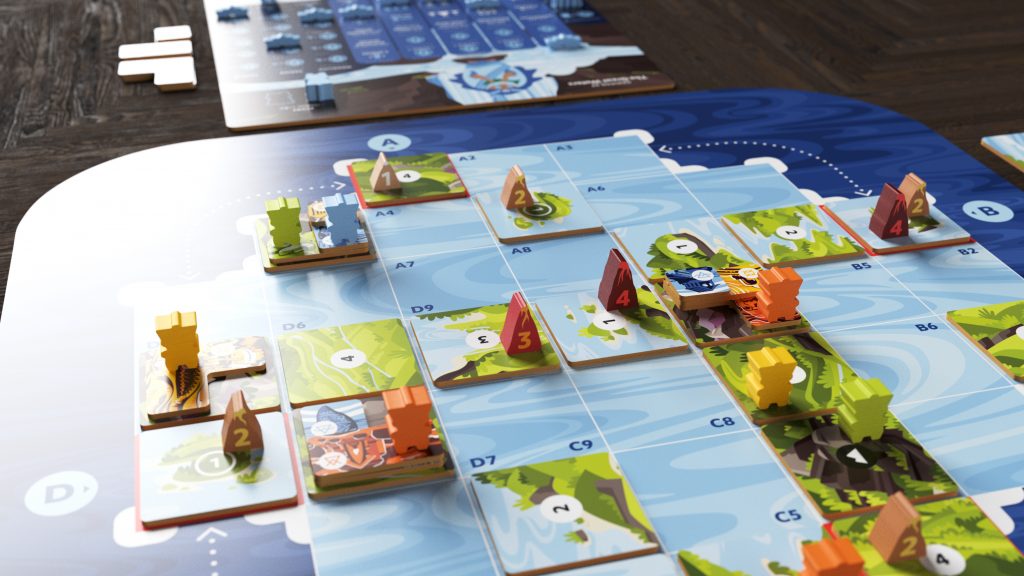
Can you walk us through your design process? Do you start with specific themes in mind or want to utilize certain mechanisms?
I’m not one to have a dozen projects buzzing around my head all at the same time. I prefer focusing on, obsessing over, constructing, nitpicking, tearing apart, and reconstructing one project at a time. If a new idea pops up, I take note, then store it away until my brain naturally returns to develop it. But keeping my mind focused on finishing, helps me make sure that I actually do finish something.
To me, a game needs to start with a hook. It’s the heart that keeps the game alive. There must be some magic, brilliant, clever thing, whether mechanic or thematic, that can inspire and ignite the imagination. The hook is the hardest part. But when you start with an “aha factor” as the foundation it informs and focuses your design decisions. You never want to dilute or lose it.
From there a game must grow, mature, and evolve. For me this process looks a little like baking the best looking cake possible, then running with it straight into a wall, over and over. Good news is: each cake you make is better than the one before. But without the devastating destruction of critical assessment and playtesting, followed by very careful reconstruction, at least from an Oros point of view, the game simply wouldn’t be what it is today. So props to all those constructive feedback givers.
Another aspect of my design process is trying and testing unconventional things. There is a lot of tearing everything apart and coming up with another possible universe and all its implications. Most of these explorations don’t pan out. But a few lead to very original breakthrough ideas.
How did you come to be involved with the guild?

In the process of showing and playtesting Oros, I heard a few folks mention the guild and suggest I connect with it. But I’m extremely introverted and really don’t like walking into places unknown so I never really got up and went. That is, until I was playing Oros with a couple of friends at the Good Move Cafe in Provo, and Andrew Allen happened to be working that night. At one point he walked by our table, stopped, and said, “I’ve never seen that game before. What is it?” So after explaining that it was my work in progress he enthusiastically invited me to come to guild meetings, got my phone number, then texted to remind me about meetings. Which he did multiple times. It took a few weeks, but I finally showed up. It was good to know someone before walking in all alone.
If you could pick 3 games that every designer should have to play, as a sort of game design curriculum, what would you choose?
#1. Concordia. This is hands down my favorite strategy game. The way it elegantly balances simple deck-building mechanics with exploration and civilization mechanics is something to learn from. As is it’s scoring methodology. I love how integrated the scoring is to what you accomplished while playing. Yet it’s all at the end, so it doesn’t get in the way of enjoying the play experience.
#2. Alhambra. The super simple game play married with the dazzling catalogue of micro expansions make this one a good study for embracing the philosophy of distilling your game down to its purest form, then using that as a foundation for added mechanic exploration. It’s three-part scoring system was also a real aha moment for me. It’s also a good example to show how color and artwork alone can cause confusion. The currency and the tiles share colors which inevitably leads to someone trying to purchase the wrong tile with the wrong currency at some point of the game. Lesson learned.
#3. Oros! Hahaha. I couldn’t resist. I do think there’s a lot to glean from this game though. The flattened globe map, the tile-shifting concept, the power board economy, the scoring paradigm. Plus, the automa system which still surprises and amazes me with how well it works. Lol.
Game Related Questions
You have been working on a game called Oros. Could you tell us more about that?
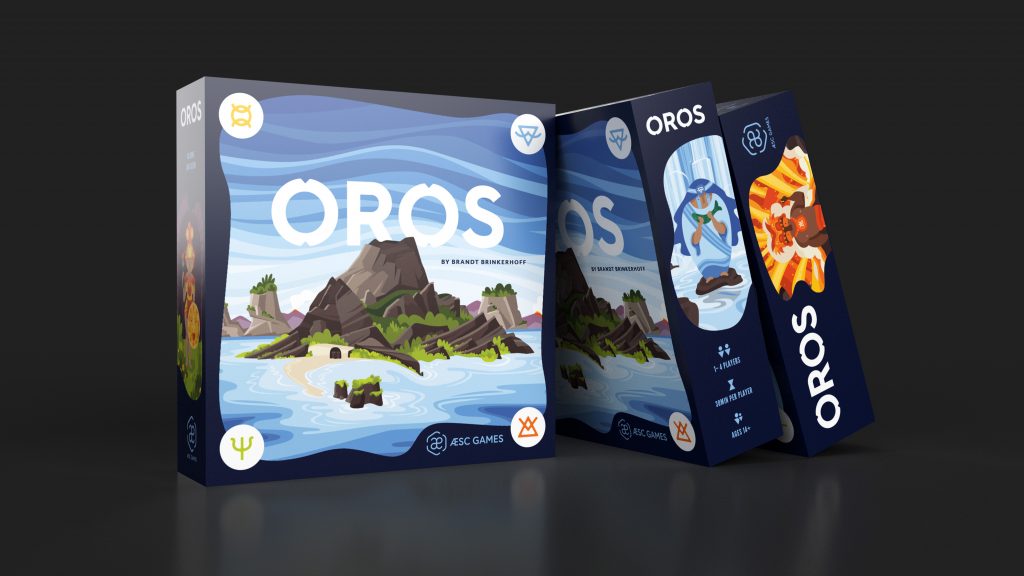
I have! It feels like it has completely taken over my life as I’ve been preparing to head to Kickstarter with it!
Oros is a tile-shifting, mountain-making strategy game. It takes real connections to geology and anthropology and combines them with worker-placement, and ability-building into a layered, puzzle-like play experience.
During the game you take actions to manipulate the shared environment where your followers are living by shifting or colliding landmasses, forming and erupting volcanoes, as well as forming immovable mountains. You can take actions to develop your civilization by navigating the ever-changing landscape, building sacred sites on mountains, and studying in sacred sites. The more you build and study the more powerful you become.
What design challenges did you have to face when designing Oros ?
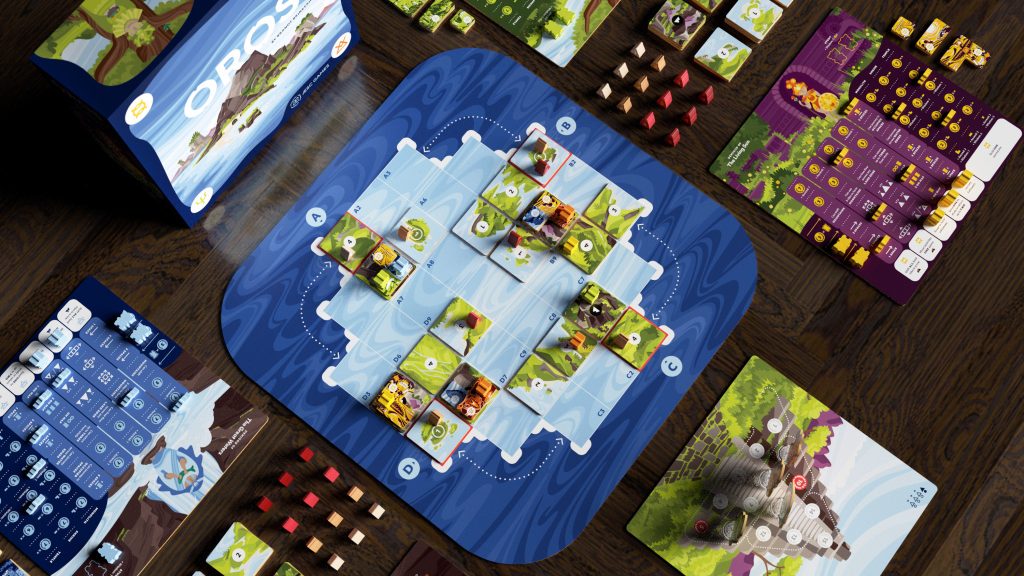
I think the biggest challenge was breaking through each evolution of the game. There were many times when people playtesting would comment that I had a finished game. And many times I believed them. But, I swear every time I finished a video for the game (to submit to a competition or for promotion) the next week I’d have some massive breakthrough. Like reconstruct-major-areas-of-the-game type of breakthroughs. So that was also quite annoying. My videos were always immediately obsolete… Anyway, I should have tracked game versions because it seemed like every single mechanic had to get a full overhaul two or three times before the whole system really started to feel balanced, elegant, and refined.
One massive challenge was designing the solo mode. I went through dozens of ideas, variations, and approaches while just flat out banging my head against a wall. I was honestly surprised at how difficult it is to engineer an automa. And I use the word engineer deliberately. The result of all that brain-wracking though, is so satisfying. It’ll probably be one of the least used parts of the full game design, yet it’s the part I’m most proud of.
Oros has won a variety of awards, could you share some of your experiences with these contests and awards?
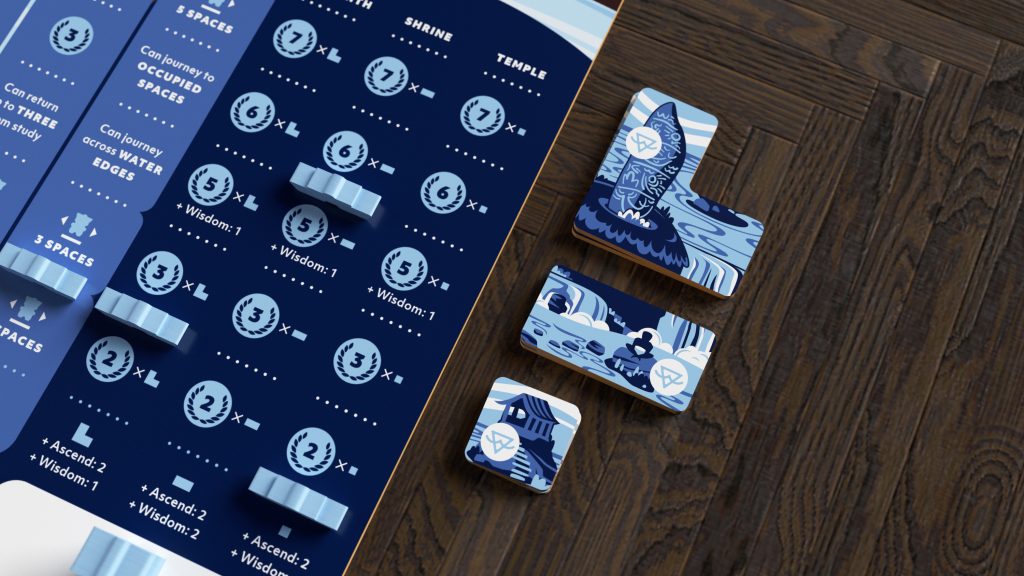
I’ve participated in four game design competitions so far and each has been a little different.
The first competition I signed up for was with the Board Game Design Workshop, which had been suggested to me by an old friend and now guild member, Jon Walton. I actually didn’t realize what I was signing up for. But the Workshop is actually a months-long multi-round event. And I was fortunate enough to power through round after round. Which was sooo good. The feedback from each round was invaluable. And the fact that I kept getting selected forced me to accelerate designing the game. It was very intense, and an insane amount of work, but very worth it in the end.
Next I entered the Ion Award. I wasn’t even going to, but a friend of mine pointed out that I have the video I needed done, and a game that had just finished the Workshop, so I may as well enter. So, I did. After getting selected as a finalist things kind of got real again, and I realized I needed to seriously push the design forward to be ready for the SaltCon showcase. Clearly it went well because I was honored with taking home the 2020 Ion Award for Strategy game.
I then entered the Board Game Design Lab Challenge, and again received unbelievably great feedback after each round. And again, got to walk away as the winner of the challenge.
And finally I’ve entered into the 2021 Cardboard Edison Award, which is running right now, and which I am a finalist in. We’ll see how this one turns out.
People tell me that by this point I should just know that if I enter I’m going to win, but honestly, I don’t know. I’ve learned from participating in these events that all sorts of unforeseen things happen. Someone was in a bad mood, someone only likes light-weight games, someone misinterpreted a single rule that tanks the entire game, or maybe they just don’t like it. COVID also made things crazy with some games being played online too. I think it’s important to embrace the reality that just because some small group demoing your game likes or doesn’t like it, doesn’t mean that the game is great or garbage. At the end of the day these things are really about feedback and/or exposure.
Do you have any advice for others when it comes to contests and awards?
Be realistic with your expectations. If you don’t try hard, you probably won’t go very far. And not all passion projects inspire the passions of others. If you are entering to get feedback, do everything you can to get your game to a point where the feedback you receive isn’t just stuff you already know. If you are entering to win, make sure you have a winning idea. You’ll need to demonstrate excellence in creative and innovative thinking, originality of idea, mechanic and thematic development, elegance in gameplay, and the better it looks aesthetically, the better you’ll do. Even though it feels like you are competing with other prototypes, you are really competing against fully developed and beloved published games. That should be your mindset. The more you can make it belong with the big guys, the more judges and publishers will see it that way and respond accordingly.
Tell us about some of the other designs you’ve been thinking about/working on.
Does designing a Kickstarter campaign count?! Just kidding, but for reals, it’s taken over everything. I do have another game I’ve started working on. It’s a worker placement game that takes place inside a time paradox. I’m super excited about it, and super not working on it right now.
Oros will be hitting Kickstarter soon, which is exciting! Can you tell us more about that?
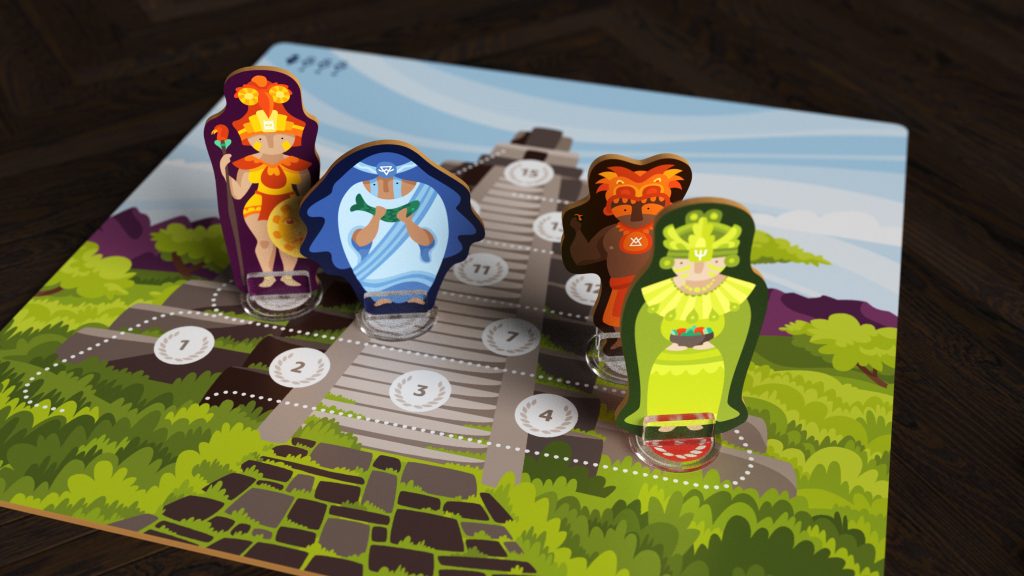
Oros is planned to launch on July 20th! It’s a big and exciting time that has taken me just over a full year of working about 20 hours per week to get to. I have a decent collection of excited folks ready to jump in and back as well as many pre-campaign channels that are out there to help people discover and get excited about the launch. Check things out on my website: www.aescgames.com, or join the Facebook group for all the ongoing behind-the-scenes type content: www.facebook.com/groups/orosboardgame.
Preparing and running a Kickstarter and publishing is so much more effort, work, and expense than designing a game. I’ve chosen to self-publish on Kickstarter. And I’ve done this for a variety of reasons, one of the big ones is to experience it and learn first hand what it takes to succeed. And wow, it’s a lot. But I’ve learned a lot. So much that it’d consume an entire other interview, so probably best to keep that vault closed for now.
Final Wrap up Questions
How would you suppose the guild could improve to better assist in the game development process?
That’s an interesting question. I’ve come to realize that there is a difference between “game design” and “game development.” The former being the concept actualization and the latter being everything from fine tuning mechanics and game processes, to the thematic integration, artwork, graphic design, basically all the millions of micro decisions to get the game retail ready. Right now, the guild really focuses on game design and playtesting. But that’s about it. Some members have a decent knowledge base in game development, but that’s not really the focus of the guild, at least as I’ve experienced.
But I’d love to see the guild get into a bit more of that knowledge share. Which we’ve seen with Lyle tapping into his TTS know-how. But there’s a wild world of learning in this space and it would be great to hear people’s experiences and tactics.
I’d also love the guild to connect a bit more into publisher rings, so we can help each other get found. I think the ProtoSynthesis and ProtoCon events could also start to bridge that space a bit.
If people wanted to contact you or follow your game designs how should they go about that?
Yus! Link dump! I’m pretty easy to get a hold of and am happy to chat anytime. You can find me in our guild Discord, or also:Email: aescgamestudio@gmail.comMessenger: brandt.brinkerhoffAesc Games Discord: https://discord.gg/exASpaY
To follow Oros or play online you can head here:Website: www.aescgames.comFacebook community: https://www.facebook.com/groups/orosboardgameFacebook: https://www.facebook.com/orosthegameInstagram: https://www.instagram.com/aescgamesTwitter: https://twitter.com/AescGamesPlay online: https://tabletopia.com/games/orosKickstarter!: https://www.kickstarter.com/projects/aescgames/oros

